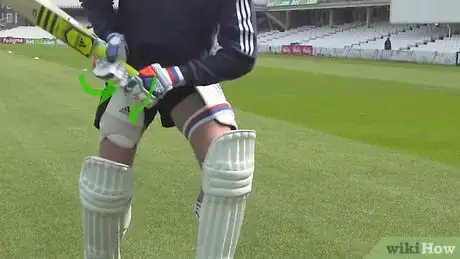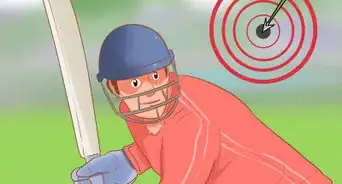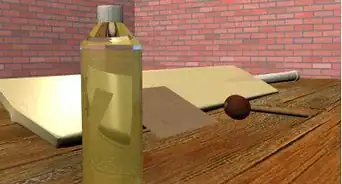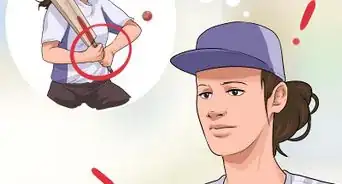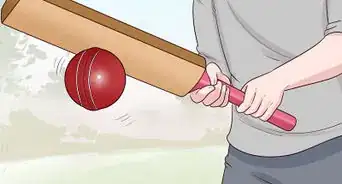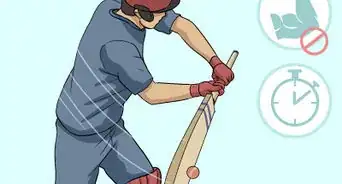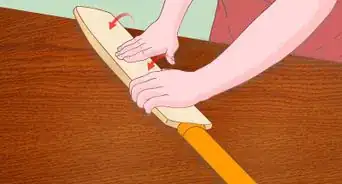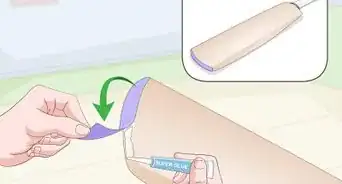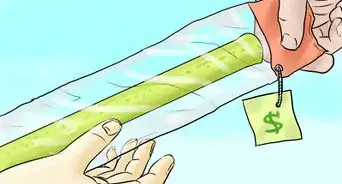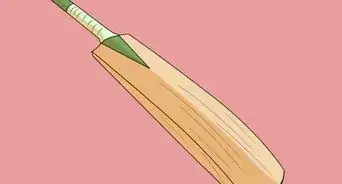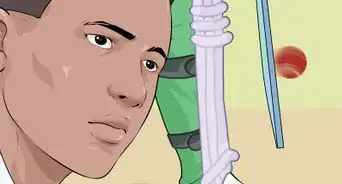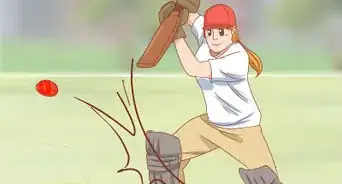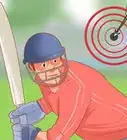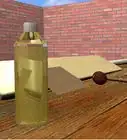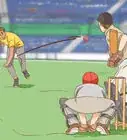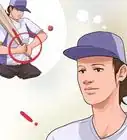This article was co-authored by wikiHow Staff. Our trained team of editors and researchers validate articles for accuracy and comprehensiveness. wikiHow's Content Management Team carefully monitors the work from our editorial staff to ensure that each article is backed by trusted research and meets our high quality standards.
wikiHow marks an article as reader-approved once it receives enough positive feedback. This article has 21 testimonials from our readers, earning it our reader-approved status.
This article has been viewed 805,589 times.
Learn more...
As a batsman in cricket, it’s your job to use the bat to defend the wicket from being hit by the ball. The wicket is made up of 3 vertical stakes, called stumps, topped by 2 horizontal blocks of wood, or bails. You’ll also have the opportunity to trade places with the other batsman (the non-striker) to score runs!
Steps
Preparing for the Shot
-
1Grip the cricket bat properly. If you're right-handed, place your left hand on top of the handle towards the toe (the rounded tip of the cricket bat) with the right hand under it; left-handers place their hands the opposite way. The thumbs and forefingers should form a "V" between the outside edge and center of the bat that points towards the toe of the bat.[1]
- Batting gloves should be worn to protect your fingers if they get hit by the ball.
-
2Assume the proper stance. If you're right-handed, stand sideways in the crease (the "safe" area in front of the wicket) with your left shoulder towards the bowler (who "pitches" the ball); left-handed batters do the opposite. Look straight over your shoulder towards the bowler; do not tilt your head. Spread your feet about 12 inches (30.5 cm) apart and bend your knees slightly with your weight distributed evenly on both legs. Rest the toe of the bat on the ground behind your feet near the wicket; your top hand will rest on the inside of the thigh nearest the bowler.[2]
Taking the Shot
-
1Shift your weight to your back foot for longer pitches. Shifting your weight away from the bowler enables you to adjust to a ball that bounces higher off of the pitch and takes longer to reach you.
-
2Shift your weight to the foot closest to the bowler for a full pitch (one that bounces close to you). Move to meet the ball.
-
3Try to hit the ball before it spins. If the bowler is bowling spin, you can advance forward and hit the ball before it spins. You can play a front foot shot for a spin bowler; this gives you the advantage of a full-toss delivery and the chance to face the ball before it bounces and spins.
-
4Swing the bat properly. When the ball is pitched, roll the shoulder facing the bowler down slightly and swing the bat backwards in a straight line. Use your top hand for control as you bring the bat forward to meet the ball.[3]
- The back-swing provides the power for the shot; a good swing clears the top of the wicket.
-
5Decide whether to attempt to score a run or continue batting. A successful batsman knows when to try to score and when to remain in position and defend the wicket. If there is no time to switch places with the non-striker and score a run, stay put and prepare for the next shot.
Choosing and Preparing the Cricket Bat
-
1Select the right cricket bat. Bats differ in length, weight, and handle type; the right bat for you depends partly on your height and partly on personal preference.[4] There are different bats depending on the type of ball you are using
- The proper length depends upon your height. Get into your batting stance and hold the cricket bat next to your front leg. The top of the cricket bat should be situated just at the top of the players pelvis (The top of your hip).
- The proper weight depends upon personal preference. Heavier bats provide more power, but lighter bats provide a faster swing. Take practice swings with cricket bats of different weights until one feels comfortable and controllable.
- The proper handle depends upon personal preference. Bats with oval handles are stronger, but round handles are easier to grip, especially with your bottom hand. Round handles also provide additional lift when you hit the ball.
-
2Prepare the cricket bat by having it knocked in. Bats are made from willow, a soft wood that is initially hardened by a mechanical press. Additional hardening improves its performance and protects against cracking.[5] While you can knock a bat in yourself, it is recommended that the process of strengthening the surface by denting and leveling it out be done by a professional.
- Rub 1 tsp. (5 g) of raw linseed oil on the bat, coating the surface evenly to promote elasticity and protect against cracking. Apply the oil either with your fingers or a cloth, using a clean cloth each time (the oil is combustible, so dispose of the cloths immediately). Let the oil soak in overnight, then oil the bat 2 additional times before beginning the actual knocking in process.
- Dent the middle of the cricket bat. Use a hardwood bat mallet designed for this purpose (a cricket ball may also be used). Continue hitting the surface until it is level and the dent has disappeared. This will take about 10 minutes using a bat mallet, and about 10 to 15 sessions are needed to complete the process.
Community Q&A
-
QuestionHow can I hit the ball hard?
 Community AnswerTo hit the ball hard, tighten the left hand (if you are right handed). The more you tighten the left hand, the more you will be able to hit hard. (Do it vice versa if you're left handed.)
Community AnswerTo hit the ball hard, tighten the left hand (if you are right handed). The more you tighten the left hand, the more you will be able to hit hard. (Do it vice versa if you're left handed.) -
QuestionHow can I focus on the ball?
 Community AnswerSit at a peaceful place. Hold a tennis ball tightly in your hand and move your hand continuously in different directions while looking at the ball. Just keep your focus on the ball and start moving your hand faster. This will cause your eyes to see the ball faster and easier. Your eye reflexes will enhance and your focus on the ball will increase, resulting in hitting better shots from the middle of your bat.
Community AnswerSit at a peaceful place. Hold a tennis ball tightly in your hand and move your hand continuously in different directions while looking at the ball. Just keep your focus on the ball and start moving your hand faster. This will cause your eyes to see the ball faster and easier. Your eye reflexes will enhance and your focus on the ball will increase, resulting in hitting better shots from the middle of your bat. -
QuestionHow do I play short balls?
 Community AnswerTo play a short ball, first shift your weight to your right leg in case you are right handed or do vice versa. Then try to play a pull shot or hook shot. If it is too high, then don't try. It may became a catch. Leave it and look at the umpire for a no-ball or a wide.
Community AnswerTo play a short ball, first shift your weight to your right leg in case you are right handed or do vice versa. Then try to play a pull shot or hook shot. If it is too high, then don't try. It may became a catch. Leave it and look at the umpire for a no-ball or a wide.
References
- ↑ https://www.youtube.com/watch?v=8oOj2x4_OMs
- ↑ https://www.youtube.com/watch?v=8oOj2x4_OMs
- ↑ https://www.youtube.com/watch?v=1I0sNdotKJY
- ↑ https://www.youtube.com/watch?v=1I0sNdotKJY
- ↑ https://www.wisden.com/stories/your-game/cricket-gear/top-six-tips-selecting-right-cricket-bat
- Videos provided by World Sport
About This Article
If you’re right-handed, hold the cricket bat with your left hand near the rounded tip of the bat, called the toe, and your right hand higher on the handle. If you’re left-handed, reverse these positions. Stand with your non-dominant shoulder towards the bowler, or the person pitching the ball, with your feet shoulder-width apart and your knees slightly bent. When the bowler pitches the ball, swing the bat backwards in a straight line, then use your top hand to control the bat as you swing it forward to hit the ball. For tips on choosing the perfect cricket bat, read on!
